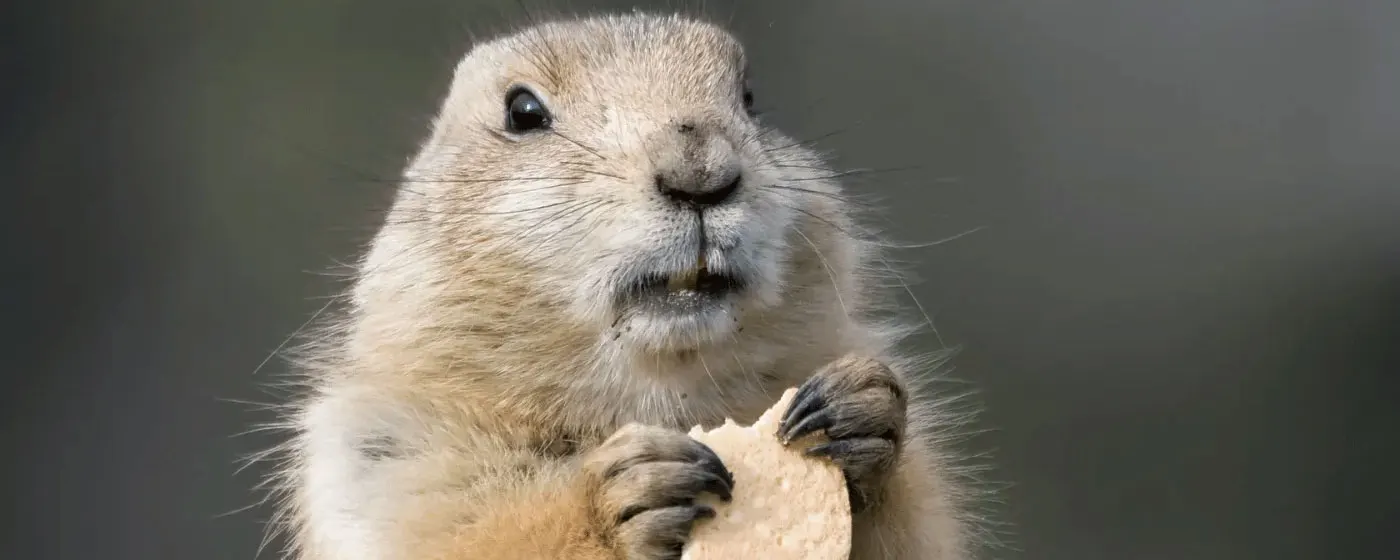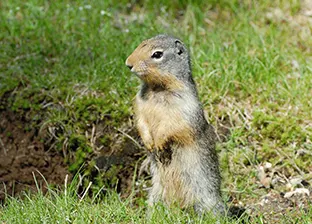So, you’re seeing a little creature pop up in your garden and you’re wondering if this might be a gopher? Or a groundhog? Or a woodchuck!? Well, actually, a groundhog and a woodchuck are one and the same. But, there are noticeable differences between a gopher and a groundhog. Let’s explore “groundhog vs. woodchuck vs. gopher”, shall we?

Physical Characteristics
When we are through this article, you will be able to determine whether the signs or sightings in your yard depict a groundhog (woodchuck) or a gopher. The animals themselves can be told apart, as can the distinct evidence they leave behind.
Gopher Appearance
Though many species exist, when we talk about gophers, we generally mean pocket gophers. Pocket? Yes, their built-in little cheek pouches, perfect for collecting and transporting food. Pocket gophers are considerably smaller than groundhogs; most weigh less than 2lbs. They have protruding incisors, usually yellowish or brown in colour. Their fur can be brown, black or beige, as is their short tail.
Groundhog Appearance
Groundhogs (or woodchucks) are part of the rodent family Sciuridae. They measure between 40cm to almost 70cm (including a relatively long tail) with a weight of 4.5lbs to well over 13lbs. Male groundhogs are generally slightly larger than females. The colour of their fur ranges from dark brown to reddish. No teeth show when their mouths are closed.
Key Differences
While they may look somewhat similar in pictures and are both considered rodents, they come from different families. Gophers are part of the Geomyidae family and close relatives to the kangaroo rat, kangaroo mouse, and the pocket mouse. Groundhogs, on the other hand, are part of the squirrel family and much larger than gophers.
Habitat and Behavior
 Where Gophers Live
Where Gophers Live
Gophers can be found all over South and North America. Their favorite landscapes include savannas, grasslands, woodland, forest, meadows, steppe, and more. An important factor is loose soil to make the digging process easier. They spend nearly all of their time underground. Elaborate tunnel systems provide space to sleep, raise their young, and store food.
Groundhog Habitats
Groundhogs are found throughout much of North America and also live in underground burrows. They are at home at the edges of woodlands, in savannas, meadows, and even pastures or agricultural fields. Oh! And, your garden! You’ll see groundhogs forage most likely in the early morning and late afternoon hours. In contrast to Gophers, they hibernate during the cold winter months.
Behavioral Distinctions
Because groundhogs and gophers are very different animals, we can expect them to live and act differently as well.
Diet and Feeding Habits
Are there differences in diet when it comes to groundhogs vs. gophers? Since they both live in very similar environments? Both, gophers and groundhogs are primarily herbivores
Gopher's Menu
Gophers consume a wide variety of different plants, roots, nuts, and seeds. Staples in a gopher’s diet include vegetables, grasses, stems, tubers, and more - depending on availability.
Groundhog's Dietary Preferences
A groundhog’s diet primarily consists of grasses and other plants. Some of its favorite foods include clover, alfalfa, dandelion, timothy grass, and buckwheat.
Groundhog vs Gopher - How do I know which one?
So, we talked about what both rodents look like. But, what if you haven’t actually spotted the offending critter? What if you’re only seeing the evidence of his presence in your yard?
The Difference Between a Gopher Hole and a Groundhog Hole
Ah yes, examining and identifying the evidence. The biggest and easiest sign to identify the type of hole you are dealing with is whether the entry (or exit) of the tunnel is covered up or open. A gopher will close up his holes and leave behind a mound of dirt while a groundhog’s hole and tunnel will be open.
Damage to Property
Whenever a rodent tunnels around your home, there is a concern about the integrity of your foundation. Both critters’ tunneling activities can create voids below your foundation and put your home at serious risk.
Gopher-Related Issues
Your friendly neighbourhood gopher can dig up 10 to 30 mounds of dirt a month in your yard, feasting on roots, vegetables, stems, and destroying just about anything in its underground path, including hydro or other cables. His elaborate tunnel network can create sinkholes in your yard which can spell disaster for pets and people alike.
Groundhog Destruction
Aside from the worry about your home’s foundation, a groundhog can take out most of your garden in a matter of days. Because they constantly need to gnaw, any wooden structures in and around your yard are also fair game. Look for teeth marks.
Contact Hawkeye for Expert Pest Control
The presence of a gopher or groundhog may bring around other unwanted guests as well. Your yard may now become the hunting grounds for predators like weasels, skunks, or snakes. But, by far the greatest worry is the foundation of your home. Don’t ignore the signs - call in a professional Animal Wildlife Control Company, such as Hawkeye.
Give us a call today and let’s issue an eviction notice to those little freeloaders in your yard.














